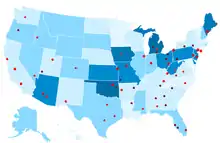American Osteopathic Association
The American Osteopathic Association (AOA) is the representative member organization for the more than 168,000 osteopathic medical doctors (D.O.s) and osteopathic medical students in the United States. The AOA is headquartered in Chicago, Illinois, and is involved in post-graduate training for osteopathic physicians. Beginning in 2015, it began accrediting post-graduate education as a committee within the Accreditation Council for Graduate Medical Education, creating a unified accreditation system for all DOs and MDs in the United States. The organization promotes public health, encourages academic scientific research, serves as the primary certifying body for D.O.s overseeing 18 certifying boards,[3] and is the accrediting agency for osteopathic medical schools through its Commission on Osteopathic College Accreditation. As of October 2015, the AOA no longer owns the Healthcare Facilities Accreditation Program (HFAP), which accredited hospitals and other health care facilities.
 | |
| Abbreviation | AOA |
|---|---|
| Formation | April 19, 1897 |
| Type | Professional association |
| Headquarters | Chicago, Illinois |
| Location |
|
| Coordinates | |
Official language | English |
President | Ernest R. Gelb, DO[1] |
CEO | Kevin Klauer, DO, EJD[2] |
| Website | AOA Official Website |
| Osteopathic medicine in the United States |
|---|
| Andrew Taylor Still (founder) |
The AOA has held yearly conventions since its founding in 1897.[4] The AOA also manages DOCARE International, a non-profit charitable organization. The AOA also publishes The DO, an online publication, and The Journal of the American Osteopathic Association, a peer reviewed medical journal.
History
The association was founded as the American Association for the Advancement of Osteopathy on April 19, 1897,[5] in Kirksville, Missouri, by students of the American School of Osteopathy specifically Andrew Taylor Still.[6][7] It was renamed the American Osteopathic Association in 1901.[7]
In September 1901, the AOA began to publish a scientific journal entitled the Journal of the American Osteopathic Association. Subscriptions were offered to AOA members, and at the time, membership fees were $5 annually.[8] The journal was published bimonthly for the first year, then monthly thereafter. In 1903, the AOA conducted the first accreditation survey of osteopathic medical schools.[9] Three years later, the American Medical Association conducted its first accreditation survey of US MD-granting medical schools.[9] In April 1927, the AOA began publishing The Forum of Osteopathy, a monthly magazine that covered news relating to osteopathic medicine, the AOA, and related groups.[8] In September 1960, the magazine was renamed The DO.
In the early 1900s, the AOA, citing concerns about safety and efficacy, was opposed to the introduction of pharmacology into the curriculum of osteopathic medicine. However, in 1929 the AOA board of trustees voted to allow the teaching of pharmacology in D.O. schools.[9] By 1938, the AOA began requiring that osteopathic medical students have at least 1 year of undergraduate college coursework, and by 1940, the AOA required two years.[9] In 1943, the AOA founded the Healthcare Facilities Accreditation Program (HFAP), an organization that accredits hospitals and other health care facilities.[10]
In 1957, the U.S. Department of Health, Education, and Welfare recognized the AOA as the official accrediting body for osteopathic medical education. In 1967, the National Commission on Accrediting (currently the Council for Higher Education Accreditation) recognized the AOA as the official accrediting agency for all aspects of osteopathic medical education.[11] The Department of Health, Education and Welfare (currently the Department of Health and Human Services) recognized the AOA as the official accrediting body for osteopathic hospitals under Medicare in 1966. In October 2015, the AOA sold the Healthcare Facilities Accreditation Program to the Accreditation Association for Hospitals/Health Systems.[12][10][13][14][15][16]
In 2016, a group of D.O. physicians filed an anti-trust lawsuit against the AOA (Talone et al. v. The American Osteopathic Association), contesting the requirement for physicians to purchase AOA membership as a condition of AOA board certification.[17][18] In 2018, the AOA and physicians reached a $35 million settlement agreement.[18] As a part of the settlement, the AOA agreed to end its policy of requiring physicians to purchase AOA membership in order to receive AOA board certification.[18][19] The settlement was finalized in 2019.[20]
In 2021, the AOA filed a lawsuit against the American Board of Internal Medicine (ABIM). The lawsuit was directed at the ABIM policy requiring program directors to be board certified by the ABIM in order for graduates of that residency to be eligible for ABIM board certification.[21]
The AOA supports the annual "D.O. Day on Capitol Hill," where more than 1,000 osteopathic physicians (D.O.s) and osteopathic medical students go to Washington, D.C. to meet with members of congress to discuss current issues in health care, such as access to care challenges.[22] The event serves as an opportunity for legislators to learn more about health care and osteopathic medicine and for medical students to become more familiar with the political process.
Osteopathic post-graduate education
The AOA also provides funding for post-graduate osteopathic medical residencies.[23] In the 2017 match, more than 2,200 osteopathic physicians matched into these residency programs.[24] In February, 2014, the AOA and AACOM decided to join with ACGME to form a unified post-graduate accreditation system.
- From July 1, 2015, to June 30, 2020, AOA-accredited training programs will transition to ACGME recognition and accreditation.
- There will continue to be osteopathic-focused training programs under the ACGME accreditation system. Two osteopathic review committees will be developed to evaluate and set standards for the osteopathic aspects of training programs seeking osteopathic recognition.
- DOs and MDs would have access to all training programs. There will be prerequisite competencies and a recommended program of training for MD graduates who apply for entry into osteopathic-focused programs.
- AOA and AACOM will become ACGME member organizations, and each will have representation on ACGME's board of directors.
Publications
The American Osteopathic Association publishes The DO, an online publication[25] covering news related to osteopathic medicine, legislation, health care changes, and osteopathic continuing medical education programs.[26]
The AOA also publishes The Journal of the American Osteopathic Association, a monthly peer-reviewed medical journal focusing on original research and editorial articles.
DOCARE International
DOCARE International is a non-profit medical charity serving remote areas of the Western Hemisphere.[27] DOCARE International primarily operates in the Caribbean, Africa, South America, and Central America.[27] DOCARE is operated by the American Osteopathic Association, and consists of osteopathic physicians, osteopathic medical students, M.D. physicians, and other healthcare professionals.[28]
See also
- American Association of Colleges of Osteopathic Medicine
- The DO
- Journal of the American Osteopathic Association
- Student Osteopathic Medical Association
References
- "About Us: Leadership & Policy". American Osteopathic Association.
- "AOA Chief Executive Officer: Kevin Klauer, DO, EJD, FACEP". American Osteopathic Association. AOA.
- "American Osteopathic Association Names Daniel Williams, DO, Vice President of Certifying Board Services". American Osteopathic Association. 20 November 2017. Retrieved 12 October 2020.
- "Annual Conventions and Meetings of the AOA". AOA. Archived from the original on 1 March 2014. Retrieved 15 September 2012.
- Mullner, Ross M (20 May 2009). Encyclopedia of Health Services Research. Google. SAGE. ISBN 9781412951791.
- Macauley, DB (June 1897). "Organization of Osteopaths" (PDF). Journal of Osteopathy: 76–78. Retrieved 5 September 2012.
- Gevitz, Norman (March 2014). "The "Doctor of Osteopathy": Expanding the Scope of Practice". The Journal of the American Osteopathic Association. 114 (3): 200–212. doi:10.7556/jaoa.2014.038. PMID 24567273. S2CID 34932814.
- "Publications Communicate Osteopathic Theory and Practice". American Osteopathic Association. 2006. Archived from the original on 16 May 2012. Retrieved 19 April 2012.
- Gevitz, Norman (June 2009). "The transformation of osteopathic medical education". Academic Medicine. 84 (6): 701–6. doi:10.1097/ACM.0b013e3181a4049e. PMID 19474540.
- "About Us". HFAP.
- "COMMISSION ON OSTEOPATHIC COLLEGE ACCREDITATION" (PDF). State of New Jersey.
- "Longtime accrediting organization to keep its name, continue to expand". HC Pro. Simplify Compliance. Retrieved June 1, 2018.
- "Outlook". mail.nyumc.org.
- "Medicare Hospital Compare Glossary". Hospitalcompare.hhs.gov. Retrieved 26 May 2012.
- "42 CFR 488.5 - Effect of JCAHO or AOA accreditation of hospitals. | LII / Legal Information Institute". Law.cornell.edu. Retrieved 9 June 2012.
- "PA AOA-Accredited Institutions & OPTIs". Poma.org. Retrieved 26 May 2012.
- George, John (Aug 2, 2016). "Class-action lawsuit filed against American Osteopathic Association over membership fees". Philadelphia Business Journal.
- George, John (July 30, 2018). "AOA & its physician members settle class-action lawsuit". Philadelphia Business Journal.
- "American Osteopathic Association details settlement agreement in class-action lawsuit". American Osteopathic Association. 27 July 2018.
- Staff Writer (January 15, 2019). "Settlement finalized in AOA class action lawsuit". The DO.
- AOA Staff (January 7, 2021). "AOA files suit against ABIM".
- Mercer Morrison (April 3, 2012). "WCUCOM students participate in D.O. Day on Capitol Hill". WDAM. Archived from the original on July 16, 2012. Retrieved 11 April 2012.
- "Family Medicine Top Specialty for Future Osteopathic Physicians". The Business Journals. February 13, 2012. Retrieved 9 April 2012.
- "AOA Intern/Resident Registration Program: Results of the 2017 Match". Retrieved 12 August 2017.
- "American Osteopathic Association - AOA". U.S. Department of Health and Human Services. Retrieved 12 August 2012.
- "Health Information Resource Database". National Health Information Resource Center. 16 December 2011. Archived from the original on 13 January 2012. Retrieved 19 April 2012.
- Gougian, Rachel; Berkowitz, Murray (October 2014). "Gray Zone: Why a Delayed Acceptance of Osteopathic Medicine Persists in the International Community". The Journal of the American Osteopathic Association. 114 (10): 754–760. doi:10.7556/jaoa.2014.145. PMID 25288706.
- Ajluni, Peter B. (December 2007). "Do care about DOCARE" (PDF). The DO. Retrieved 25 September 2012.
